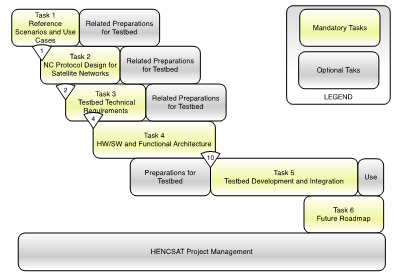
-
StatusCompleted
-
Status date2020-08-19
-
Activity Code3A.069

HENCSAT created a test bed for application of Network Coding to heterogeneous satellite based communication networks. This is relevant since satellite communication increasingly is used as a complementary addition to other radio communication solutions, and there is an opportunity to combine all, rather than select one, or multiple networks.
As about 70% of all Internet traffic is video, HENCSAT is particularly including video and photo communication. Since satellite networks commonly are used for mission-critical communication the focus is further on use of visual communication for information and situational awareness purposes.
Users are expected to be mobile, and networks are assumed to be changing as a function of time and location. Links are expected to have errors and traffic is assumed to be IP-based.
HENCSAT specifically targeted two concreate objectives that were modelled and generalized to cover a broader scope:
- Sending visual information from UAVs using satellite communication in combination with available terrestrial networks.
- Receiving visual data to a convoy of vehicles, or ships, forming a moving cluster where the nodes are interconnected using Wi-Fi and were some or all also are connected to Internet via satellite and/or terrestrial networks.
In this project, several key challenges were identified to deliver reliable visual-data communications with network coding:
- Mobility, mean that networks are changing, potentially unpredictably, and thus estimates of capacity and conditions is history.
- Dynamic resource allocation over multiple networks with changing availability, capacity, congestion and packet loss conditions.
- Efficient video compression for highly dynamic networks where minimum capacity may be as low as around 100 kbps if only satellite communication is available and tens of Mbps if several cellular networks are present under best case conditions.
- Selecting Network Coding rates for the conditions in question with different and varying erasure rates
- Optimal use and load of the network taking into account the cost of satellite communication and relevance of the data.
In addition to these challenges the right test bench design was a general challenge.
The HENCSAT test bench helped users find solutions that provide better capabilities for critical services over heterogeneous networks that include satellite. Novel innovation beyond state-of-the-art for satellite networking was created that opens up for exploitation of new and powerful services.
Later solutions based on HENCSAT will be able to create product far beyond current state of the art, and position Europe as leading innovator in the relevant satellite networking areas.
HENCSAT solutions increased user experience for visual communications when satellite-links are use in the access domain for either sender, receiver or both sides, for a wide range of applications such as:
- UAV operations
- Mobile convoy situations
- Critical operations
- Safety, security, search and rescue
- Use of Network Coding in satellite networks
- Virtualization and 5G integration of satellite networks.
The novel technologies are implemented in a testbed, and the key benefits are verified. The technologies are ready to explore further and take to a products phase, potentially flown in a UAV.
Main Features of HENCSAT:
- Test bench for studying and investigation the use of Network Coding in heterogeneous multi-homing networks that included at least one satellite communication component.
- Application to both Northbound and Southbound scenarios; sending and receiving visual and bandwidth-demanding operationally critical data.
- Significantly better quality and lower cost for end-to-end visual communication under packet-loss conditions.
- Higher throughput rates and smaller residual packet losses with network coding as compared to state-of-the-art routing protocols.
- Demonstration testbed with several network nodes in parallel topology.
- Application layer multicasting possible to clusters of users.
- Optimal use of video compression for changing networks.
- Robust network coding adapted to counter varying packet losses in the system comprises of several networks including SatCom, WLAN, 2G/EDGE/3G/4G, etc.
Selected non-exclusive use Case Scenarios:
- Video streaming from UAVs
- Video to, within and from Convoys
While the challenges are complex, the basic system architecture is relatively simple:
- UAV scenario:
- Camera connected to computer
- Computer connected to multiple networks.
- Networks connected to Internet and receiving node.
- Convoy Scenario:
- Internet video or other data source
- A cluster of receivers requesting the same data.
- Cluster nodes may have one or more Internet connections
- Cluster nodes are interconnected with a wireless LAN.
The two scenarios are interconnected in the top drawing of this web page.
The duration of the project was 18 scheduled for months.
The basic planning is shown below.

The kick-off of the project was 1st October 2016.
The project is on completed.



